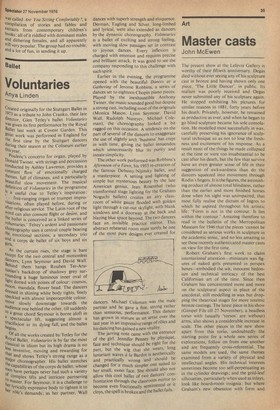Ballet
Voluntaries
Anya Linden
Created originally for the Stuttgart Ballet in 1973 as a tribute to John Cranko, their late director, Glen Tetley's ballet Voluntaries was given its first performance by the Royal Ballet last week at Covent Garden. This great work was performed in England for the first time by the Stuttgart dancers during their season at the Coliseum earlier this Year.
Poulenc's concerto for organ, played. by bonald Twiner, with strings and percussion conducted by Ashley Lawrence, provides a constant flow of emotionally charged themes, full of climaxes, and a particularly beautiful slow movement. The musical definition of Voluntaries in the programme ;s a useful clue to Tetley's inspiration: • • . free-ranging organ or trumpet improvisations, often played before, during or after religious service. The Latin root of the Word can also connote flight or desire, and tile ballet is conceived as a linked series of voluntaries.' Teltey's ardent and passionate choreography uses a central couple bearing the emotional sections, a secondary trio and a corps de ballet of six boys and six girls.
As the curtain rises, the stage is bare except for the two central and motionless dancers, Lynn Seymour and David Wall. aehind them hangs Rouben Ter-Arutunian's backdrop of shadowy grey sur,1101Inding a huge luminous inner oval of right dotted with points of colour: cosmos, thoon, mandala, flower head. The dancers dressed in shining white body tights, finely sPeckled with almost imperceptible colour, 4.10ve slowly downstage towards the atidience one behind the other, till suddenly t° a great chord Seymour is borne aloft in .s4 spectacular lift, suggesting almost a spectacular in its dying fall, and the ballet Degins.
R Of all the works created by Tetley for the ,°Yal Ballet, Voluntaries is by far the most 'assical in idiom but its high drama is no 1tess inventive, moving and rewarding for at and shows Tetley's strong range as a tilthaJor choreographer. His ballet stretches e capabilities of the corps de ballet, whose "olfen have perhaps never had such a variety to Complex lifts and intricate partnering Lo Master. For Seymour, it is a challenge to Ih'er lyrically expressive body to tighten it to her role's demands; as her partner. Wall
dances with superb strength and eloquence. Derman, Eagling and Silver, long-limbed and lyrical, were also extended as dancers by the dynamic choreography. Voluntaries is a ballet of exciting and strong feeling, with moving slow passages set in contrast to joyous dances. Every inflexion is charged with emotion and requires precise and brilliant attack. It was good to see the company responding to this challenge with such spirit.
Earlier in the evening, the programme opened with the beautiful Dances at a Gathering of Jerome Robbins, a series of dances set to eighteen Chopin piano pieces. Played by the inexhaustible Anthony Twiner, the music sounded good but despite a strong cast, including most of the originals (Monica Mason, Lynn Seymour, David Wall, Rudolph Nureyev, Michael Coleman), the choreography looked a bit ragged on this occasion. A tendency on the part of several of the dancers to exaggerate the use of slightly arch 'business' has crept in with time, giving the ballet innuendos which unnecessarily blur its purity and innate simplicity.
The other work performed was Robbins's Afternoon of a Fawn, his 1953 re-creation of the famous Debussy/Nijinsky ballet, and a masterpiece. A setting and lighting of simple but mysterious beauty by the late American genius, Jean Rosenthal (who transformed stage lighting for the Graham Noguchi ballets) creates an airy classroom of white gauze flooded with golden light through a cut-out skylight, with blank windows and a doorway at the back and blazing blue space beyond. The two dancers face an invisible practice mirror. This abstract rehearsal room must surely be one of the most pure designs ever created for
dancers. Michael Coleman was the male partner and he gave a fine, strong rather than sensuous. performance. This dancer has grown in stature as an artist over the last year in an impressive range of roles and his dancing has gained a new vitality.
The jarring note came with the entrance of the girl. Jennifer Penney by Physique, face and technique should be right for the part, but the wig that she wears, long luxuriant waves a la Bardot is aesthetically and practically wrong and should be changed for a much simpler one suited to her small,
sweet face. She should also not allow this cool ballet of two dancers' confrontation through the classroom mirror to become even fractionally sentimental or it cloys, the spell is broken and the ballet fails.










































 Previous page
Previous page